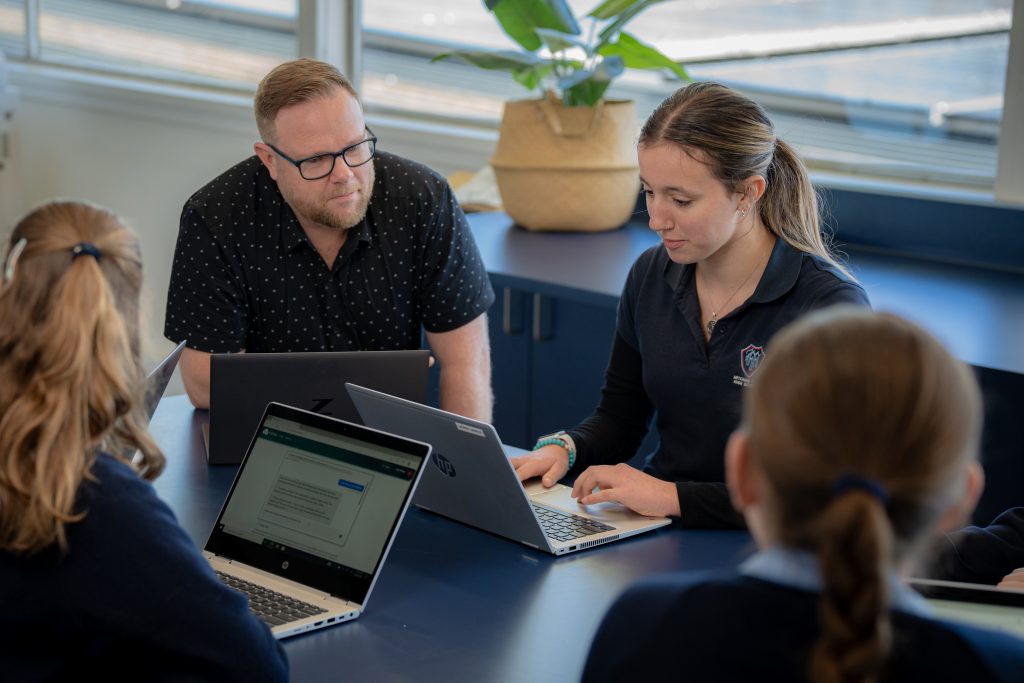
South Australian students are supercharging their creativity and critical thinking with AI in the classroom
South Australia was the first state in the nation to announce that it would not be banning generative AI and chatbots in schools, choosing instead to let principals deci de if and how tools like ChatGPT would be used.
de if and how tools like ChatGPT would be used.
The SA Department for Education has since developed a world-leading AI chatbot, EdChat, designed specifically for teaching and learning. It was built in partnership with Microsoft and uses the Azure OpenAI service, powered by the same technology as ChatGPT.
Over 1,500 students and 180 educators across 8 schools took part in the SA Department for Education’s 8-week trial of the chatbot in classrooms, which concluded in August 2023.
Microsoft caught up with Martin Westwell, Chief Executive of the SA Department for Education, to learn more about the trial and the Department’s plans for the future.
Microsoft (MSFT): What was the Department’s initial response to generative AI and what is its strategy moving forward?
Martin Westwell (MW): When ChatGPT was released to the public, we knew immediately that it would change everything. We know that young people are going to go out into a world where generative AI and other forms of AI will be embedded in every industry, and they need to be able to navigate that world with confidence. The question was not whether or not we introduce AI to schools, but how.
It’s a really complex and interesting challenge for us to figure out how to respond to generative AI. In the education space, the two most important concepts underpinning systems’ strategies are ‘evidence-based’ and ‘best practice’. When it comes to AI, neither of these concepts are easy to tackle as we just don’t know enough yet.
So, what we aim for instead is good practice. What does that look like? It means keeping trials small and controlled so that we can provide the right level of support and engagement with educators. And it means proceeding with caution and humility, not assuming that we will get the same results every time and staying flexible in our approach.
We’re shaping an entirely new way of learning, so we need to understand how we can maximise the potential value of generative AI while minimising the risks.
MSFT: What was the idea behind EdChat?
MW: We wanted to understand what generative AI could do and what its limitations are, as well as how we can embed it into students’ learning so that they use it as part of their process rather than just to get results. We needed a version of ChatGPT that we had full control over and one that we could ensure was safe and appropriate for student use.
We were able to navigate those safety concerns by leveraging our existing investment in Microsoft, using the Azure AI Content Safety service to build controls into the system. The Department has full control over how EdChat is trained to detect, moderate and block potentially harmful content. It also gives school staff full visibility over how students are using it as all interactions with EdChat are comprehensively logged and securely stored in the Department’s private tenancy.
We wanted teachers to understand what generative AI can do and how they can leverage it to improve students’ learning while introducing some efficiency and ease into their teaching process.
We also wanted to see how students used EdChat during the trial and listen to their ideas. It’s their tool after all, and we want to foster the sense of ownership and agency they feel over it as a crucial part of their education.
MSFT: How do you ensure that students’ creativity and critical thinking are being encouraged rather than threatened by the technology?
MW: There are always going to be ways to use AI to just generate a bunch of answers. But what we are failing to acknowledge when we assume that’s all students will use it for is their inherent curiosity. Imagine being able to ask any question at any time and get an answer perfectly suited to your needs. And imagine being able to interrogate that answer further, ask your source where it gets its information from and debate different sides of an argument with it. Imagine being able to bounce off your ideas for a story or poem and getting suggestions to make it better, or references to other famous works that can inspire you. That’s what students can do with EdChat.
EdChat is built using the same technology as ChatGPT, so it can pull from a vast range of sources and deliver this information to students’ fingertips. Having this level of easy access has encouraged students to expand their metacognition, or their own understanding of how they learn and think. They are learning to ask different kinds of questions to get different kinds of answers. EdChat can help them brainstorm ideas drawing from other cultures and disciplines they otherwise may lack exposure to.
It also makes students more confident in directing their own learning and asking questions that they may be embarrassed to ask out loud. The technology gives them a safe space to take risks, challenge themselves and explore their thoughts and ideas.
I think that if we had buried our heads in the sand and banned AI and chatbots in schools, students would likely have continued using it at home to simply generate answers and churn out assignments. By introducing it in schools as part of learning, we’re ensuring that they really understand how it can supercharge their thinking and creativity rather than replace it. We’re teaching students how to use AI effectively and responsibility to support their learning.
MSFT: What did you learn from introducing EdChat into real-world classroom settings as part of the 8-week trial? Did it deliver any unexpected benefits to teaching and learning?
MW: One of the most important takeaways from the trial was seeing students realise that they couldn’t always trust EdChat’s answers to be accurate. That was extremely important to us as there was a misconception before the trial that generative AI would mean they never have to struggle over an assignment again. But now they’re thinking harder, questioning ideas and learning crucial critical thinking skills that will set them apart in the real world.
Another interesting benefit was how EdChat helped maintain momentum in the classroom. Students found that they didn’t need to wait for the teacher to make their way around the class to check in on them since they could have that initial back-and-forth with EdChat. This freed up the teacher’s time so they could spend it on students who need more support and also ensured that the time they do spend with students is used for more complex or in-depth discussions about the student’s thinking and how they are using EdChat.
MSFT: What are the Department’s future plans for EdChat and AI more broadly?
MW: Now that the first trial is complete, we have confidence in EdChat’s underlying infrastructure and the safety measures and controls we put in place. We know that it works and that it’s safe and appropriate. Our next steps are to keep trialling it in different schools, especially those with a lower level of digital maturity and those in rural or remote areas so we better understand what they need EdChat to be able to do. And our focus remains on what we can learn from the trials, not what we can achieve.
We also want to engage with students, teachers and parents around generative AI in education and address their concerns for safety and privacy. There needs to be confidence in the technology so that everyone can move forward together.
We will continue to engage heavily with partners like Microsoft along the way as we explore the potential that AI can have on education together. Students are our most important stakeholders and introducing AI in schools is empowering the next generation to shape Australia’s future.














